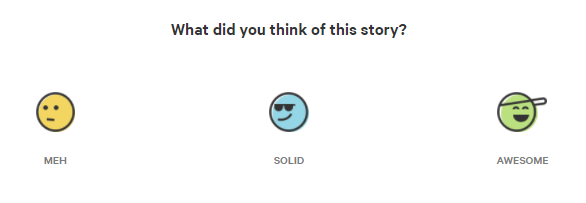
Sentiment analysis is a game-changing natural language processing system that gauges what large groups of people are saying.
On a base level, sentiment analysis determines whether annotated text data is positive, negative, or neutral. Natural language processing (NLP) and machine learning algorithms make sense of data through text classification.
Practically, it helps businesses monitor brand and product customer feedback to better understand customer needs.
There are a few different types of sentiment analysis we want to discuss in this article. Then we’ll touch on how it’s done and how it benefits a company like yours.
How are we feeling about sentiment analysis so far? Positive enough to keep reading, we’re sure.
Types of Sentiment Analysis
Sentiment analysis can move beyond positive, negative, or neutral to offer more specific feelings.
It can cover a wide spectrum, as well as detect more specific feelings and even intentions. The level of information you receive is dependent on your specific needs, and the output is tailored accordingly.
Here’s a look at some of the main types of sentiment analysis.
Graded Sentiment Analysis
Negative-Neutral-Positive can help you get a sense of how people are feeling about a specific product or service of yours. You can also focus on a specific keyword or topic that’s buzzworthy within your industry or field.
If you want to expand the spectrum to include different levels, that’s where graded sentiment analysis comes into play.
A great example of this is Google’s 5-star review system. It’s great when people take the time to write a basis for their star rating, but if you only have the stars to analyze, you can read them as follows:
- 5 stars = Very positive
- 4 stars = Positive
- 3 stars = Neutral
- 2 stars = Negative
- 1 star = Very negative
This gives you a more precise classification when there’s no specific text data to feed the machine.
A similar example would be the rating system on Goodreads. There, you can add a review to the more general 5-star scale.
Emotion Detection
This type of sentiment analysis helps pinpoint emotions customers are expressing in their feedback, from happy and satisfied to angry and frustrated.
A site like The Athletic, for example, allows readers to comment on articles, but also offers a simpler “what did you think of this story” feedback option.

The format allows for some creativity. Tracking and inputting the responses gives you a look at what types of stories and which writers people connect with. You also learn the topics readers embrace or see as boring or contentious.
Sometimes, though, emotional statements can be misleading when they come in text form. Let’s say someone loves an article that’s fresh and unique, and they write “this article is sick, you’re killing it!” Sick and killing it in this context are actually positive sentiments, and the NLP must be trained to recognize them as such.
Emotion detection, as you might expect, also plays a key role in emotional AI.
Aspect-Based Sentiment Analysis
Speaking of training the NLP system, they can also be given the ability to determine whether the text data expresses an implicit positive or negative sentiment.
For example, customers can often jump on company websites to initiate a service call with a chatbot. In order to determine to whom they should be directed, the bot will ask “what can I help you with?” The customer will type something like “the picture on my TV is too dark” or “I need to cancel my streaming subscription because there are too many bugs.”
These are apparent issues with the product or service that need to be flagged as negative and rectified in order to improve the user experience.
Benefits of Sentiment Analysis
For starters, this NLP system allows you to gauge customer feedback – and large amounts of it – in real time.
In order to train and test the sentiment analysis machine learning models, developers need high-quality data collected at scale. The more data they have to work with, the better the NLP will become at reading, understanding and analyzing the data its fed.
With all this training data, the NLP is better equipped to meet your specific needs, giving you the most accurate and meaningful data possible.
Let’s say you’re a startup launching a new app. You want the rollout to be as smooth as possible, for people to adopt it quickly, maybe even get featured in the app store. Even a few early-bird reviews can get you off the ground or ground you at takeoff.
The real-time aspect of sentiment analysis is key. If there’s an issue that’s hindering the UX or keeping people from accessing the app altogether, you need to know about it and correct it as soon as possible to avoid going viral for all the wrong reasons.
You never get a second chance to make a first impression, as the saying goes. Using sentiment analysis, you don’t have to scroll through Google reviews or Twitter feeds and pull the feedback manually, all while saving time and money.
A Finger-Clickin’ Good Example
Major, successful corporations use sentiment analysis. A great example is KFC, a brand that was struggling under the weight of seemingly healthier alternatives.
According to The App Solutions, “KFC started riding on the waves of memes and pop culture iconography (most recently by using RoboCop to promote the newest product) to instill the brand’s value proposition.”
The idea is users connect with the brand and are led to engage with the product as a result.
The method combines sentiment analysis in social networks monitoring and campaign management that involves:
- Performance monitoring with aspect-based sentiment analysis
- Topic mining to extract new ideas and variations
KFC is now more present in the media landscape, and that presence is resulting in the steady growth of the reach and ultimately the market share.
The Sentiment Analysis Process
It all begins by training the machine learning model to recognize whether the data is negative, positive, or neutral. This requires manual text classification of customer feedback.
Humans do the legwork of training the NLP, teaching it to deliver desired outcomes by first feeding it tagged examples.
Text data annotation is so vital. Again, data powers the whole process. In this case, that data is naturally formed written text (like a Google or Facebook review) that needs to be transcribed and annotated.
The tagging process is an important human step that should not be taken lightly since they make or break the real-life performance of the model. As a result, the ML algorithm can make associations between real and expressed meanings to interact more naturally.
Medallia, for example, developed a software-as-a-service platform that helps clients capture and analyze feedback from customers and employees. Customers give feedback on the phone, in store, online, or on mobile devices. Those opinions offer valuable insights in real-time.
Using Medallia’s multilingual solutions helps their clients make smarter, more informed daily decisions, build better customer relationships, and improve company culture.
Let Our Approach to Sentiment Analysis Help You
Summa Linguae’s process was built over time and is constantly refined. The process is in place to give you what you want, even if you don’t know exactly what that looks like just yet.
We become “experts” on certain industries to get a sense of what kind of topics people are concerned about within, and in relation to common services and products.
It allows you the freedom to work on other things and has opened the door to begin implementing base topic sets that can be mined for important information right out of the gate.
We provide end-to-end data solutions to get your project where you want it to be.
Contact us today to learn more.


